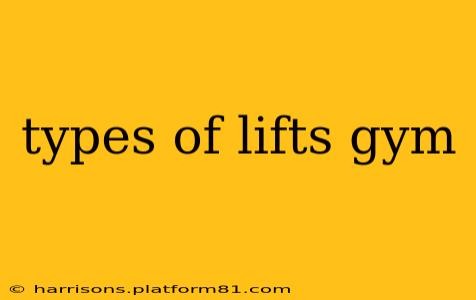The gym can feel like a maze of confusing machines and intimidating free weights. Understanding the different types of lifts is crucial for building strength, muscle mass, and improving overall fitness. This guide breaks down various gym lifts, categorizing them for clarity and explaining their benefits. We'll cover everything from foundational compound movements to more specialized isolation exercises.
Compound Lifts: The Foundation of Strength Training
Compound lifts are exercises that work multiple muscle groups simultaneously. These are the cornerstone of any effective strength training program because they build overall strength and power more efficiently than isolation exercises. They also boost your metabolism and contribute to significant calorie burn.
1. Squats:
This king of compound lifts targets your quads, glutes, hamstrings, and core. Variations include:
- Barbell Back Squats: The classic squat, utilizing a barbell across your upper back.
- Front Squats: The barbell rests across your front shoulders, emphasizing quads and core stability.
- Goblet Squats: Holding a dumbbell or kettlebell close to your chest, ideal for beginners.
- Sumo Squats: A wider stance emphasizes the inner thighs and glutes.
2. Deadlifts:
A full-body movement that strengthens your back, hamstrings, glutes, and forearms. Proper form is paramount to prevent injury. Variations include:
- Conventional Deadlifts: The most common variation, emphasizing the posterior chain (back and legs).
- Sumo Deadlifts: A wider stance, placing more emphasis on the quads and glutes.
- Romanian Deadlifts (RDLs): Focuses on hamstrings and glutes with less emphasis on the lower back.
3. Bench Press:
This classic upper-body exercise primarily targets the chest muscles (pectorals), but also works the shoulders (deltoids) and triceps. Variations include:
- Barbell Bench Press: The standard bench press using a barbell.
- Incline Bench Press: Elevates the bench, emphasizing the upper chest.
- Decline Bench Press: Lowers the bench, targeting the lower chest.
- Dumbbell Bench Press: Offers greater range of motion and allows for independent arm movement.
4. Overhead Press:
This movement works your shoulders (deltoids), triceps, and upper back. Variations include:
- Barbell Overhead Press: Using a barbell to press overhead.
- Dumbbell Overhead Press: Allows for a greater range of motion and more balanced shoulder development.
- Arnold Press: A variation involving a twisting motion, engaging more shoulder muscles.
Isolation Exercises: Targeting Specific Muscle Groups
Isolation exercises focus on a single muscle group, allowing for targeted hypertrophy (muscle growth) and improved muscle definition. These are often used after compound lifts to finish off a muscle group.
1. Bicep Curls:
This targets the biceps brachii muscle in the front of your upper arm. Variations include:
- Barbell Curls: Using a barbell to curl the weight.
- Dumbbell Curls: Allows for independent arm movement and better range of motion.
- Hammer Curls: Holding dumbbells with a neutral grip.
2. Triceps Extensions:
This focuses on the triceps brachii muscle on the back of your upper arm. Variations include:
- Overhead Dumbbell Extensions: Extending dumbbells overhead.
- Cable Pushdowns: Using a cable machine to push down a handle.
- Skullcrushers: Lying on a bench and extending a barbell or dumbbells.
3. Lateral Raises:
This targets the medial deltoids (side shoulders). Variations include:
- Dumbbell Lateral Raises: Raising dumbbells out to the sides.
- Cable Lateral Raises: Using a cable machine.
4. Leg Extensions:
This isolates the quadriceps (front of the thighs).
5. Hamstring Curls:
This isolates the hamstrings (back of the thighs).
What are the best types of lifts for beginners?
Beginners should focus on mastering the fundamental compound lifts: squats, deadlifts, bench press, and overhead press. These exercises build a strong foundation of strength and muscle mass. Start with lighter weights and focus on proper form before gradually increasing the weight.
What are some examples of gym lifts that target specific muscle groups?
Isolation exercises are excellent for targeting specific muscle groups after completing compound movements. Examples include bicep curls (biceps), triceps extensions (triceps), lateral raises (shoulders), leg extensions (quadriceps), and hamstring curls (hamstrings).
How do I choose the right type of lift for my fitness goals?
Your choice of lifts should align with your fitness goals. For overall strength and muscle building, prioritize compound lifts. For muscle definition and hypertrophy, incorporate isolation exercises. Consult with a qualified fitness professional to create a personalized plan tailored to your individual needs and goals.
This guide provides a comprehensive overview of various gym lifts. Remember to prioritize proper form and gradually increase weight to avoid injury. Consulting a certified personal trainer can help you create a safe and effective workout plan.
